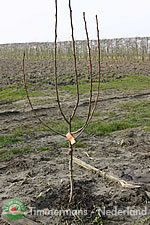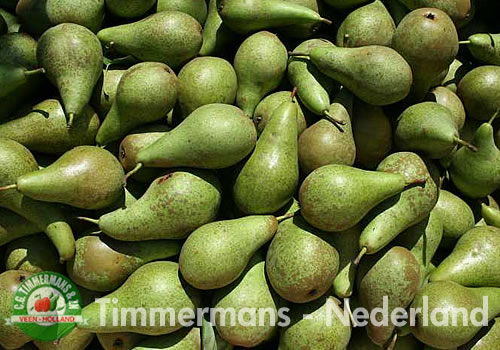Conference is currently the most widely cultivated pear in the Netherlands and in Belgium, accounting for about 70% of production. Conference is also the main variety grown in England. In addition Conference is grown widely in France, Italy and Spain.
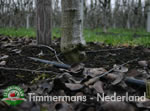 In modern pear cultivation the variety is grafted on to understock. For Conference this is usually Quince MC or Quince Adams. Using understock clearly results in weaker growth, which in fact leads to earlier and improved productivity.
In modern pear cultivation the variety is grafted on to understock. For Conference this is usually Quince MC or Quince Adams. Using understock clearly results in weaker growth, which in fact leads to earlier and improved productivity.
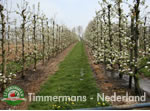 The stock material is cultivated by specialised fruit tree nurseries. The understock is planted in the spring and budded in July or August of the first year of growth. In this procedure an eye of the Conference variety is grafted on to the understock. During the autumn of this first year the eye fuses with the understock. By pruning the understock in the following spring back to just above the eye, the grafted eye is forced to sprout, so the plant develops a shoot of the grafted variety in the first year. This may become a tree ready for immediate sale, but usually the nursery will keep it a third year to ensure it grows into a fruit tree with balanced branches.
The stock material is cultivated by specialised fruit tree nurseries. The understock is planted in the spring and budded in July or August of the first year of growth. In this procedure an eye of the Conference variety is grafted on to the understock. During the autumn of this first year the eye fuses with the understock. By pruning the understock in the following spring back to just above the eye, the grafted eye is forced to sprout, so the plant develops a shoot of the grafted variety in the first year. This may become a tree ready for immediate sale, but usually the nursery will keep it a third year to ensure it grows into a fruit tree with balanced branches.
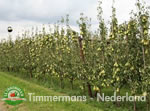 After a cultivation period of two to three years the fruit trees are sold to fruit growers. The young fruit trees are planted about 1 to 1.25 meters apart, leaving sufficient space for a track between the rows, so that the grower can drive a tractor through the orchard. This enables the grower to care for the trees and means that the harvest can easily be transported to the cold store. Fruit trees can be cultivated in various shapes, the spindle and V-hedge forms being the most common systems. In the spindle form, the tree has a leader and four to six branches (main branches) at a height of 50 or 60 cm. The final height of the leader is usually about 3 metres. The V-hedge is usually formed from four main branches that grow upwards at an angle and that are held in place by wires and stays. These branches are usually kept at about 2.5 metres.
After a cultivation period of two to three years the fruit trees are sold to fruit growers. The young fruit trees are planted about 1 to 1.25 meters apart, leaving sufficient space for a track between the rows, so that the grower can drive a tractor through the orchard. This enables the grower to care for the trees and means that the harvest can easily be transported to the cold store. Fruit trees can be cultivated in various shapes, the spindle and V-hedge forms being the most common systems. In the spindle form, the tree has a leader and four to six branches (main branches) at a height of 50 or 60 cm. The final height of the leader is usually about 3 metres. The V-hedge is usually formed from four main branches that grow upwards at an angle and that are held in place by wires and stays. These branches are usually kept at about 2.5 metres.
During the last decade trees have sometimes been planted much closer together, at 40 to 50 cm intervals. This type of planting is derived from that used by monks in old monastery gardens. These trees have no side branches, but they do have small fruit bearing side shoots.
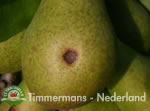 Compared to other varieties, Conference is not particularly sensitive to disease. A small proportion of orchards are cultivated organically (about 1%). The other orchards are cultivated with integrated disease and pest control and most growers work according to the EurepGAP standards. The main diseases that affect Conference are canker (Nectria), scab (Venturia) and black fruit spot (Stemphylium). The main insect pests that affect Conference are pear suckers (Pear Psylla) and codling moth (Cydia).
Compared to other varieties, Conference is not particularly sensitive to disease. A small proportion of orchards are cultivated organically (about 1%). The other orchards are cultivated with integrated disease and pest control and most growers work according to the EurepGAP standards. The main diseases that affect Conference are canker (Nectria), scab (Venturia) and black fruit spot (Stemphylium). The main insect pests that affect Conference are pear suckers (Pear Psylla) and codling moth (Cydia).
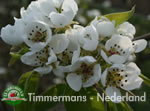 To maintain the shape of the trees they are pruned every year in the winter months. The shoots without flower buds are cut away together with part of the fruiting wood. A feature of current-day cultivation is to ensure that the fruit is well-exposed to the light. In the past the majority of the fruit was shaded and this fruit did not grow as large or have as much flavour as the fruit in the light. Also the trend for smaller fruit trees makes it easier to thin out the trees meticulously, which benefits the size and quality of the fruit. Each year growers spend between 100 and 200 hours per hectare on thinning the trees to produce the right amount of fruit. In a mature orchard growers aim to achieve the ideal of 200,000 to 250,000 pieces of fruit per hectare. And in well-managed orchards only a small proportion of the fruit will be smaller than 55 mm in diameter and approximately 50% of the fruit will be larger than 65 mm.
To maintain the shape of the trees they are pruned every year in the winter months. The shoots without flower buds are cut away together with part of the fruiting wood. A feature of current-day cultivation is to ensure that the fruit is well-exposed to the light. In the past the majority of the fruit was shaded and this fruit did not grow as large or have as much flavour as the fruit in the light. Also the trend for smaller fruit trees makes it easier to thin out the trees meticulously, which benefits the size and quality of the fruit. Each year growers spend between 100 and 200 hours per hectare on thinning the trees to produce the right amount of fruit. In a mature orchard growers aim to achieve the ideal of 200,000 to 250,000 pieces of fruit per hectare. And in well-managed orchards only a small proportion of the fruit will be smaller than 55 mm in diameter and approximately 50% of the fruit will be larger than 65 mm.
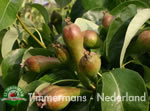 The skin of a Conference usually has some degree of russeting (rough skin). This is one of the properties of the variety. There are many factors affecting the amount of roughness of the fruit. The main cause is frost after full blossoming and lack of water in the first six weeks after flowering, so it is a great advantage if a pear orchard has irrigation.
The skin of a Conference usually has some degree of russeting (rough skin). This is one of the properties of the variety. There are many factors affecting the amount of roughness of the fruit. The main cause is frost after full blossoming and lack of water in the first six weeks after flowering, so it is a great advantage if a pear orchard has irrigation.
In well-managed orchards a grower can begin to harvest from the second or third year after planting. The orchard will be in full production in the fifth or sixth year and the grower can expect to harvest an average of 40,000 to 50,000 kg/hectare. Well-managed Conference orchards may be productive for as long as 30 to 40 years.
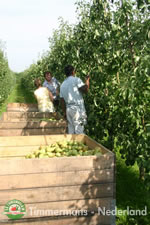 Conference pears are harvested by hand in the first half of September. These days the pears are harvested into bulk bins containing 300 to 400 kg of fruit. Some of the pears are sorted immediately and sold, but the majority of the harvest is put into cold storage. The cold store is kept at -1°C with low oxygen and high carbon dioxide levels. In these conditions Conference pears can be stored for 8 to 11 months without appreciable loss of quality or flavour. The pears are graded and packaged prior to being sold. During grading the pears are washed and sorted per 5 mm diameter. The pears are packed according to quality, up to three quality classes may be used. Together with the five or six different size classes this results in a large number of sorting classes.
Conference pears are harvested by hand in the first half of September. These days the pears are harvested into bulk bins containing 300 to 400 kg of fruit. Some of the pears are sorted immediately and sold, but the majority of the harvest is put into cold storage. The cold store is kept at -1°C with low oxygen and high carbon dioxide levels. In these conditions Conference pears can be stored for 8 to 11 months without appreciable loss of quality or flavour. The pears are graded and packaged prior to being sold. During grading the pears are washed and sorted per 5 mm diameter. The pears are packed according to quality, up to three quality classes may be used. Together with the five or six different size classes this results in a large number of sorting classes.
Source Timmermans - The Netherlands ( www.timfruit.nl )
